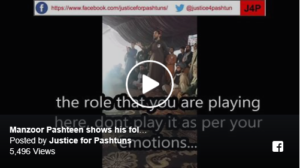Minds of the Movement
An ICNC blog on the people and power of civil resistance
by Ilam KhanJune 04, 2018
Since the US government launched the war on terror in 2001, Pakistan’s Pashtun population has been caught up in the crossfire between Taliban and state security forces. As a regional population of Federally Administered Tribal Areas (FATA) of Pakistan, the Pashtun have been an easy target for harassment and scapegoating, and have suffered from years of disappearances, extra-judicial killings, and other forms of violent repression at the hands of both the Taliban and Pakistani security forces.
But through nonviolent collective action that eventually became known as the Pashtun Protection Movement (also the “Pashtun Tahafuz Movement”, or PTM), the Pashtun have recently seen some of their demands met and at least some of their suffering eased. And still, their struggle continues.
The Pashtun Articulate Their Demands
The trigger for mobilizing came in January this year, when police killed a young Pashtun man of 27, who was arrested on unfounded allegations of involvement with terrorist groups. This sparked months of protests around the country, including notably a 10-day march-turned-sit-in (the “Long March”) in the capital of Islamabad in February. Activists sang the Pashtun Anthem, which decries injustices that the Pashtun have long suffered: What will we do with this freedom when our children are killed?
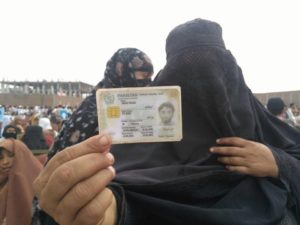
A woman displaying the identity card of a missing male family member during a PTM demonstration in Peshawar. Source: Author.
In addition to demanding an end to brutality against their people, marchers also demanded:
- Removing landmines planted by Pakistani security forces during a military operation against the Taliban across FATA, which claimed the lives of a number of civilians.
- Abandoning ‘collective punishment’ of tribes in FATA when terrorist activity is detected. When incidents occurred in FATA, security forces surrounded that area and punished the entire locality where the incident happened.
- Creating a judicial commission to investigate extra-judicial killings and examine the thousands of Pashtun disappearances for which the marchers blame the Pakistani army.
- Putting a stop to security forces humiliating Pashtun tribesmen at check posts.
- Abolition of the Watan Card, a special identity card (not a national identity card) issued by the military personnel deployed in the locality. It is required for locals to move freely to and from their areas and homes.
On the tenth day of the February sit-in, the government announced that it would grant Pashtuns’ demands (all but the investigation commission and justice for the 27-year-old man’s killing). This was in part due to the widespread popularity of the Pashtun Protection Movement—not only across the Pashtun region and some parts of Pakistan but also around the world, which has generated visible support for the Pashtun cause.
But the story does not end here. Since February, the PTM has kept the heat on Pakistani officials to follow through on their promises. The PTM has organized nonviolent gatherings in several Pashtun majority areas including Quetta, Peshawar, and Swat, including a huge gathering in Peshawar on April 8; large processions on April 22 in Lahore and in the province of Punjab, and on May 13 in Karachi during which social activists of other ethnic groups conveyed their support for the PTM; and a procession on April 29 in Swat, where the conflict against the Taliban recently ended but the military is still deployed, and where the number of missing persons is higher than any other Pashtun majority areas.
All the while, the Pakistani government has worked diligently to counter the PTM with new waves of repression, and even launched a counter-movement called the Pakistan Protection Movement. In addition to detention and torture of activists, the government has forbidden electronic and print media from covering Pashtun Protection Movement processions and protests.
Popular Slogans
Most of the slogans that people chant at PTM nonviolent actions have been taken from the ‘Pashtun anthem’:
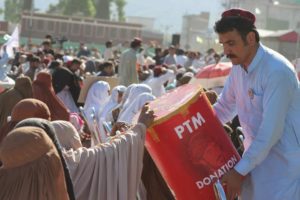
PTM contributions collection. Source: Author.
Zwanan mu qatal kegee (Our youngsters are killed)
Korona mu wraneegee (Our homes are destroyed)
Pakhtun pa k gharkegee (Pashtun are sinking)
Da sangaazadi da (Then what is this freedom for?)
And the most popular slogans of PTM are:
Ye jo dashat-gardi hey, esky peechy wardi hey (The uniform [military] is behind this terrorism)
Ye jo namaloom hey, ye hamen maloom hey (We know all the unknown persons)
Ye jo talib-gardi hey, esky peechy wardi he (The uniform [military] is behind this Talibanization)
The Pashtun Spring: Leadership and Small Successes
As the Pashtun Spring (as some onlookers have begun calling it) has continued, the widely respected and charismatic Manzoor Pashteen, age 26, who had initiated the Long March in February, has emerged as a PTM movement leader.
The PTM has achieved many successes, small and large, including:
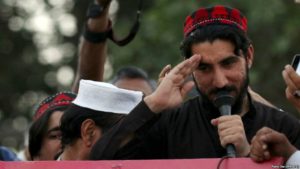
Manzoor Ahmed Pashteen, age 26, who has emerged as a PTM leader. Source: Author.
- About 300 Pashtun have been able to return to their homes.
- Some security force checkpoints have been dismantled.
- The Watan Card has been abolished.
- Civilians’ abductions have been decreasing, as have extra-judicial killings.
- Most importantly, the movement has developed a sense of solidarity and courage to express their grievances through nonviolent means, despite harsh government repression.
Impressively, the movement’s commitment to nonviolent discipline has also never wavered. Click below to watch a striking video clip of Pashteen showing his followers how to respond nonviolently to police violence (link to video posted on Justice for Pashtuns' Facebook).
The Young, the Elderly, and the Future of the PTM
An interesting feature of the movement is that it was initiated by young people from FATA, which goes against traditional Mashar (elder) leadership. Historically, elders were the ones making all the decisions impacting Pashtuns, and youngsters followed them. Now it seems to be the other way around.
From this arises many questions that need to be answered, such as, why did traditional Pashtun leadership fail to resolve the issues and grievances of the people of FATA for so long? How did youth emerge as regional leaders in pressing for rights and protection of the Pashtun?
These are only a few of the questions that we and others ask ourselves. Many are also debating about whether the PTM should expand their struggle to protect the rights of other ethnic groups living in the country. In addition, people are wondering about what role mainstream political parties, which have largely been silent on the conflict, should play in ensuring that the movement translates into broader political and social change for the country.
Amid these questions, and as time goes on, there is a risk that the PTM could be hijacked by non-state actors, or turn to violence, or succumb to state repression. But at the moment, the movement has shown its strength through nonviolent action, and there is an opportunity now for mainstream political groups and other potential allies to join hands with the PTM to strengthen the federation, the judiciary, and the supremacy of the constitution, which have all been degraded since Pakistan’s independence.
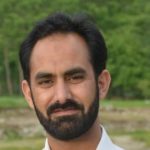
Ilam Khan
Ilam Khan is pursuing a Ph.D. at the Center for International Peace and Stability (CIPS) at the National University of Sciences and Technology (NUST). He is also currently a Research Fellow in the department of Political Science and Legal Studies at the University of Massachusetts, Amherst, USA.
Read More